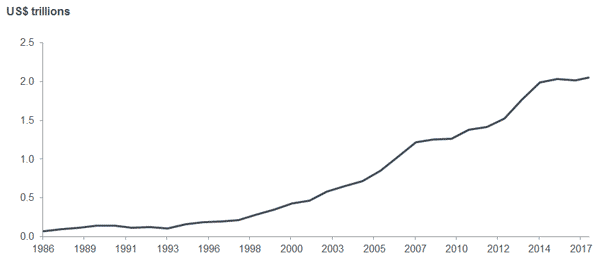Ein höchst ungewöhnlicher Zyklus — die Schrumpfung des High-Yield-Marktes

6 Minuten Lesezeit
There are many aspects of this credit and business cycle, which continue to surprise investors and differ from the textbook expectations of an aging bull market. Jenna Barnard explores one aspect unique to the high yield market, which can explain the relentless demand for bonds.
Along with many asset classes, so-called ‘junk’ bonds are experiencing a year of unparalleled tranquillity. Indeed, the Bank of America US High Yield Index is trading in the tightest spread range of the past 20 years with a high to low range in spreads of only 71 basis points (bp) year to date, while the range has been 118bp for European high yield. This compares to an average of 481bp for the US index over the last 10 years, since the start of the Global Financial Crisis.
While the reasons for the low volatility environment across asset classes are well rehearsed, we wanted to explore one aspect, which is unique to the high yield market and can help explain a relentless demand for bonds. Quite simply, the US high yield market is beginning to shrink. In doing so it is following in the footsteps of the European high yield market where the par value (notional amount) of bonds outstanding peaked in 2014 and has been notably lower ever since (chart 1).
Chart 1: shrinking high yield markets
 Source: BofA Merrill Lynch Global Research, BofA Merrill Lynch Bond Indices, Janus Henderson Investors, as at 30 October 2017.
Source: BofA Merrill Lynch Global Research, BofA Merrill Lynch Bond Indices, Janus Henderson Investors, as at 30 October 2017.
Driving forces
Explaining the shrinkage in the market is relatively simple; it is due to a number of forces, which are explored below. Before doing so however, it is worth taking a step back to reflect on the fact that eight years into a bull market, with close to record low yield levels, corporates appear to lack the exuberant animal spirits that in the past would have encouraged a leveraging up of balance sheets.
It would appear that the scars of the previous crisis continue to run deep. We have spoken in previous articles and videos about the experience of Japan and the lasting impact of a ‘balance sheet recession’ on both corporate and household attitudes to debt. It is also the case that a low growth and low inflation backdrop makes it hard for companies to envisage ‘growing into’ a highly indebted capital structure. Europe led the way in this regard but it is fascinating to see similar footprints in the US.
Changing corporate behaviour
Facing an economic environment with stagnant growth, European corporates have remained relatively conservative in their behaviour. We have commented in the past on the low levels of European merger and acquisition (M&A) activity in this business cycle relative to previous cycles, and the US.
This is particularly noteworthy given how cheaply European corporates can borrow in public bond markets. The European investment grade market currently yields 0.75% and the European high yield market yields 2.12%. The lure of cheap debt seems to exert little force on the European corporate psyche. This has not been the case in the US where investment grade companies have taken full advantage of lower bond yields in this cycle in order to return cash to equity investors.
The US high yield market, however, currently seems to have more in common with Europe, driven by a cautious attitude among private equity sponsors. This is very different to the gung ho attitude exhibited during the 2005-07 private equity boom.
Resurgence of rising stars
While the number of credit rating downgrades has exceeded the number of upgrades in the high yield universe, the volume of debt being upgraded to investment grade has far outweighed that being downgraded to the high yield index.
Typically, it is companies with the bigger capital structures (which make up a larger part of high yield indices) that are engaged in improving their credit profile. Not only does this give them access to cheaper and more plentiful funding (should they need it) in the investment grade market, if and when this cycle eventually turns, they will also be in a relatively better position to weather the storm.
The result is – across both US and Europe – a smaller high yield market, as more bonds are upgraded to investment grade.
The upgrade of Anglo American alone earlier this year, resulted in the loss of $9.6bn (par value) of bonds in the US high yield index. Tesco, which makes up 5.7% of the smaller sterling high yield index, has announced it is focusing on a return to investment grade and is buying back debt with that view in mind. In the case of the European high yield market, Barclays estimates €20bn of debt (par value) will migrate from high yield to investment grade in 2018 with only approximately €5bn going in the opposite direction.
A newfound affinity with loans
In addition to corporates’ changing business strategies, the high yield bond market has faced cannibalisation from its sister asset class – leveraged loans.
Indeed, possibly the biggest trend in the past two to three years for the high yield market has been the resurgence of loan issuance driven by the continued strong demand for collateralised loan obligations (CLOs) and a sense of protection offered by floating rate notes in a ‘rising rate environment’ (or not, as the case may be).
Borrowers have tended to prefer leveraged loan structures, which typically come with far fewer covenants, allowing more operational flexibility for the issuing firm; over 75% of loans outstanding are classified as ‘cov-lite’. In addition to this, the issuers retain the ability to repay or refinance the terms of these loans at very short notice. A large part of loan activity, particularly this year, has been companies refinancing outstanding loans at lower margins.
There is a lot of overlap in the companies that issue high yield bonds and issue debt (loans), and it is no coincidence that the rapid increase in leveraged loans has coincided with a period of decline for high yield debt. Since the end of 2014, the US high yield market has shrunk by 3.7% while the loan market has grown by 12.7%.
In aggregate, the combined size of the US loan and high yield bond markets has been broadly stable since 2014 (chart 2). Again, this is very different to the wave of mega leveraged buyouts (LBOs), which expanded the high yield and loan markets in the 2005-07 period.
Chart 2: combined size of US high yield and loan markets
 Source: BofA Merrill Lynch, Janus Henderson Investors, as at 30 September 2017
Source: BofA Merrill Lynch, Janus Henderson Investors, as at 30 September 2017
Where do we go from here?
There are many aspects of this credit and business cycle, which continue to surprise investors and differ from the textbook expectations of an aging bull market. Our guidepost for much of the divergence in behaviour between European and US corporations continues to be the experience of Japan in recent decades; erasing the memory of a debt trauma takes more than low interest rates.
In contrast, areas where we have observed a willingness to binge on debt in this business cycle are: emerging market corporates, US investment grade companies and the household sector in Australia and Canada. Each such debt boom presents different investment opportunities and risks to an unconstrained bond fund.
Divergence remains the dominant theme for bond investors.
Note: Yields and spreads quoted are correct at the time of writing in late October. Yields may vary and are not guaranteed.
Die vorstehenden Einschätzungen sind die des Autors zum Zeitpunkt der Veröffentlichung und können von den Ansichten anderer Personen/Teams bei Janus Henderson Investors abweichen. Die Bezugnahme auf einzelne Wertpapiere stellt keine Empfehlung zum Kauf, Verkauf oder Halten eines Wertpapiers, einer Anlagestrategie oder eines Marktsektors dar und sollten nicht als gewinnbringend angesehen werden. Janus Henderson Investors, die mit ihr verbundenen Berater oder ihre Mitarbeiter haben möglicherweise eine Position in den genannten Wertpapieren.
Die Wertentwicklung in der Vergangenheit ist kein zuverlässiger Indikator für die künftige Wertentwicklung. Alle Performance-Angaben beinhalten Erträge und Kapitalgewinne bzw. -verluste, aber keine wiederkehrenden Gebühren oder sonstigen Ausgaben des Fonds.
Der Wert einer Anlage und die Einkünfte aus ihr können steigen oder fallen. Es kann daher sein, dass Sie nicht die gesamte investierte Summe zurückerhalten.
Die Informationen in diesem Artikel stellen keine Anlageberatung dar.
Marketing-Anzeige.
WICHTIGE INFORMATIONEN
Bitte lesen Sie die folgenden wichtigen Informationen zu den Fonds im Zusammenhang mit diesem Artikel.
- Ein Emittent einer Anleihe (oder eines Geldmarktinstruments) kann möglicherweise nicht mehr in der Lage oder nicht mehr bereit sein, Zinsen zu zahlen oder Kapital an den Fonds zurückzuzahlen. Wenn dies geschieht oder der Markt dies für möglich hält, sinkt der Wert der Anleihe.
- Wenn die Zinssätze steigen (oder sinken), hat dies unterschiedliche Auswirkungen auf die Kurse verschiedener Wertpapiere. Insbesondere fallen die Anleihekurse im Allgemeinen, wenn die Zinsen steigen. Dieses Risiko ist allgemein umso höher, je länger die Laufzeit einer Anleiheinvestition ist.
- Der Fonds investiert in hochrentierliche Anleihen (ohne Investment-Grade-Rating), die zwar in der Regel höhere Zinssätze bieten als Investment-Grade-Anleihen, aber spekulativer und anfälliger für ungünstige Veränderungen der Marktbedingungen sind.
- Einige Anleihen (kündbare Anleihen) geben ihren Emittenten das Recht, Kapital vor dem Fälligkeitstermin zurückzuzahlen oder die Laufzeit zu verlängern. Emittenten können diese Rechte ausüben, wenn dies für sie vorteilhaft ist. Dies kann sich auf den Wert des Fonds auswirken.
- Wenn ein Fonds ein hohes Engagement in einem bestimmten Land oder in einer bestimmten Region hat, trägt er ein höheres Risiko als ein Fonds, der breiter diversifiziert ist.
- Der Fonds kann Derivate einsetzen, um sein Anlageziel zu erreichen. Dies kann zu einer „Hebelwirkung“ führen, die ein Anlageergebnis vergrößern kann, und die Gewinne oder Verluste des Fonds können höher sein als die Kosten des Derivats. Derivate bringen jedoch andere Risiken mit sich, insbesondere das Risiko, dass ein Kontrahent von Derivaten seinen vertraglichen Verpflichtungen möglicherweise nicht nachkommt.
- Wenn der Fonds oder eine währungsabgesicherte Anteilsklasse versucht, die Wechselkursschwankungen einer Währung gegenüber der Basiswährung des Fonds abzumildern, kann die Absicherungsstrategie selbst aufgrund von Unterschieden der kurzfristigen Zinssätze zwischen den Währungen einen positiven oder negativen Einfluss auf den Wert des Fonds haben.
- Wertpapiere innerhalb des Fonds können möglicherweise schwer zu bewerten oder zu einem gewünschten Zeitpunkt und Preis zu verkaufen sein, insbesondere unter extremen Marktbedingungen, wenn die Preise von Vermögenswerten möglicherweise sinken, was das Risiko von Anlageverlusten erhöht.
- Die laufenden Kosten können teilweise oder vollständig aus dem Kapital entnommen werden. Dadurch kann das Kapital aufgezehrt oder das Potenzial für Kapitalwachstum verringert werden.
- Der Wert von CoCo-Bonds (Contingent Convertible Bonds) kann drastisch fallen, wenn die Finanzkraft eines Emittenten nachlässt und ein vorher festgelegtes Auslöseereignis zur Umwandlung der Anleihen in Aktien des Emittenten bzw. der teilweisen oder vollständigen Herabschreibung der Anleihen führt.
- Der Fonds könnte Geld verlieren, wenn eine Gegenpartei, mit der er Handel treibt, ihren Zahlungsverpflichtungen gegenüber dem Fonds nicht nachkommen kann oder will, oder als Folge eines Unvermögens oder einer Verzögerung in den betrieblichen Abläufen oder des Unvermögens eines Dritten.
